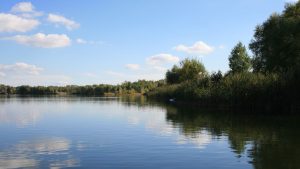Information not accurate?
Help us improve by making a suggestion.
Lake Athabasca, straddling the Saskatchewan-Alberta border in Canada, is a majestic glacial lake nestled in a rugged and pristine landscape. With a surface area of approximately 7,936 square kilometers, it is a significant destination for both nature enthusiasts and adventure seekers. The lake is home to 23 species of fish, including the prized lake trout, walleye, yellow perch, and northern pike, making it a paradise for anglers.
Nearby, the historic town of Fort Chipewyan, with its rich fur-trading history, offers a glimpse into the region’s past. Uranium City, once a thriving mining community, is another key settlement in the area. During the summer, visitors can explore the lake’s vast waters via boat launches and marinas, or engage in water sports such as kayaking and canoeing. The Lake Athabasca Sand Dunes, the largest active sand dunes north of 58° latitude, are a unique attraction adjacent to the southern shore in Saskatchewan.
In the winter, the lake transforms into a frozen expanse perfect for ice fishing, snowmobiling, and dog sledding. The surrounding wilderness, including Wood Buffalo National Park, offers ample opportunities for cross-country skiing and snowshoeing. The area’s remote and untouched beauty makes it an ideal destination for those seeking an authentic wilderness experience, whether in the warmth of summer or the crispness of winter.
- Surface area (km)
- 7935
- Max depth (m)
- 124
- Elevation (m)
- 207
- Shoreline length (km)
- 2540.35
Ideal for
- Family friendly:
- Pet friendly:
- Romantic getaways:
Popular activities
- Boating
- Kayaking
- Canoeing
- Fishing
- Freshwater Fishing
- Fly Fishing
Islands
Located in the northeast area of the lake, Johnston Island is part of a cluster of islands south of the Crackingstone Peninsula. This island is significant for its excellent fishing spots, particularly for lake trout, northern pike, Arctic grayling, and whitefish. The island’s terrain, with its tangled maze of reefs and bays, provides a sheltered environment that is ideal for both the fish and fishermen. The island is also home to a fly-in fishing lodge that caters to anglers seeking to exploit the rich fishing resources of Lake Athabasca.
Nearby amenities
When you visit Lake Athabasca, prepare to be captivated by its breathtaking expanses and the tranquility of its remote surroundings. This vast body of water is not only a stunning sight but also a vital part of the region’s ecosystem, attracting a variety of wildlife and offering a space for reflection and connection with nature. The serene beauty of the lake invites you to take leisurely walks along its shores or embark on a fishing expedition, providing plenty of opportunities to relish the great outdoors.
Just a short journey away, you will discover the wonders of Wood Buffalo National Park, which extends into Saskatchewan. This UNESCO World Heritage Site is rich in biodiversity, showcasing an array of landscapes from wetlands to boreal forests. Wander through the park to witness the diverse fauna, including the majestic bison, or explore historical sites that speak to the area’s deep cultural heritage. As you traverse this wild terrain, you’ll come across various archaeological sites that hint at the region’s storied past, inviting you to ponder the lives of those who walked these lands long before us.
While the area lacks urban amenities like restaurants or shops, its charm lies in the simplicity of its unspoiled nature. This remote escape is ideal for adventurers and nature lovers seeking to immerse themselves in the wild, away from the hustle and bustle of city life. Each moment spent here, surrounded by breathtaking landscapes and rich history, creates an unforgettable experience that invites you to slow down and truly appreciate the serene beauty of Saskatchewan.
Information not accurate?
Help us improve by making a suggestion.
Frequently Asked Questions
Ready to dive into what Lake Athabasca has to offer? Let’s tackle some of the burning questions you might have as you plan your visit!
-
No, it is not safe to swim in Lake Athabasca. Community leaders in Fort Chipewyan have expressed concerns about water quality due to potential contaminants from barges and the nearby Alberta oil sands. Independent water-quality testing is ongoing to assess the safety of the water.
-
Lake Athabasca is a popular destination because of its commercial fishing, particularly for whitefish and lake trout. The lake is also significant for its gold and uranium mines, and it is near Canada’s largest national park, Wood Buffalo National Park. Additionally, it has historical importance with settlements like Fort Chipewyan and Uranium City.
-
Yes, there are specific size and catch limits for fishing in Saskatchewan, which apply to waters including those near Lake Athabasca. For example, the daily limit for walleye is four, with only one exceeding 55 cm, and for northern pike, it is five, with only one exceeding 75 cm.
-
There is no beach specifically at Lake Athabasca mentioned in the sources. However, for families, Baptiste Lake, Hope Lake, or Jackfish Lake are good options as they offer playgrounds, picnic areas, and boat launches, making them suitable for a family day out.
-
The closest town to Lake Athabasca in Saskatchewan is Uranium City. It is located about 10 km from the lake’s north shore and is significant for its gold and uranium mines. Uranium City is connected to Fort Chipewyan on the lake’s southwestern shore by a steamer service from June to October.


